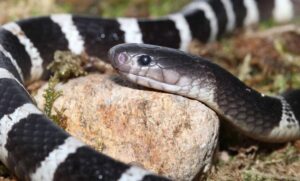If a sloth were a person, it would probably never make it to school because of its tardiness. This tree-dwelling animal sleeps up to 20 hours a day! And even when it’s awake, a sloth barely moves. In fact, they are so incredibly slow and lazy that algae grows on their bodies. Let’s continue our exploration of Interesting Facts About Sloths with KnowAllAnimals!
1. Top 10 Interesting Facts About Sloths That Will Surprise You
Sloths are some of the most peculiar and fascinating animals in the natural world. With their slow lifestyle, unique habits, and special survival abilities, these animals never fail to surprise scientists and animal lovers. This article will reveal 10 interesting facts about sloths that you may have never known.
1.1. An Introduction to Sloths
Sloths are a suborder of mammals that includes medium-sized animals belonging to the two-toed and three-toed sloth families, with a total of six species.
| Kingdom: | Animalia |
| Phylum: | Chordata |
| Class: | Mammalia |
| Superorder: | Xenarthra |
| Order: | Pilosa |
| Suborder: | Folivora Delsuc, Catzeflis, Stanhope, and Douzery, 2001 |
Their common characteristics are their slowness and lack of movement. They have a rather dopey, indifferent appearance, but this is an evolutionary adaptation to their habitat. In environments with limited nutrients, they must conserve energy by limiting their movement. They sleep about 10 hours a day and have a very balanced diet, which consists mainly of green vegetables.
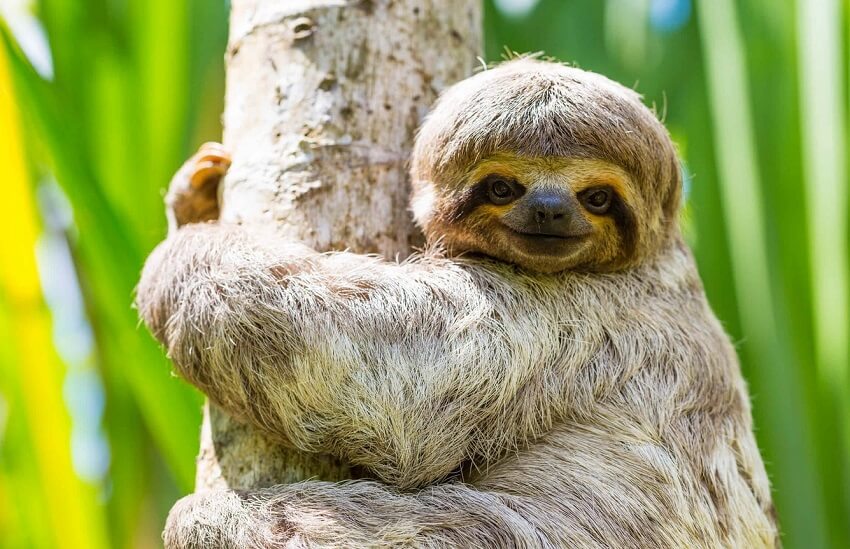
1.2. The Origin of Sloths
Modern sloths are related to the extinct giant ground sloths, an ancient species that had no fangs, lived on the ground, and was a relative of today’s sloths. The ground sloth had sharp claws and could stand on its hind legs. They were nearly 6m (20 ft) long and weighed 4 tons, the same weight as an African elephant. Ground sloths were slow-moving, herbivorous mammals. Their sharp claws helped them grab leaves from branches to eat.
The tree-dwelling sloths of today are descendants of these large-bodied mammals. When food on land became less abundant, these ancient sloths began to explore the sea for food. During times of food scarcity, these ancient sloths could dive into the sea to eat seaweed in shallow water, and later they could wade out farther and dive deeper. However, the sloths did not fully transition to a marine lifestyle; it was a temporary solution during difficult times.
1.3. Speed of Movement
The common traits of sloths are their slowness and lack of movement, along with their rather “dumb” appearance. Their indifference to everything around them leads many to believe that they are slow to evolve and have fallen behind the development of other animal species.
As their name suggests, sloths are quite lazy. They use very little energy. Their movements are always so slow that they seem motionless and blend into their environment. On land, the fastest speed they can achieve is 160 meters (525 feet) per hour. Their movements look like the slow-motion technique used in cinema.
Their climbing speed is 4 meters (13 feet) per minute. In a dangerous situation, such as being pursued, a sloth can speed up to a maximum of 4.5 meters (15 feet) per minute. On the ground, they move even more slowly, crawling only about 3 meters (10 feet) per minute. Swimming is probably the activity they are best at. Sloths can move at a speed of up to 13.5 meters (44 feet) per minute in the water.
They are so slow that algae can grow on their bodies. Their digestive system is as slow as their body. Occasionally, a sloth will crawl to the ground to drink water and relieve itself, but this is very rare. They come down to the ground once a week to eliminate waste. They are so lazy that some sloths have even died but their bodies remain hanging from the trees, never falling to the ground.
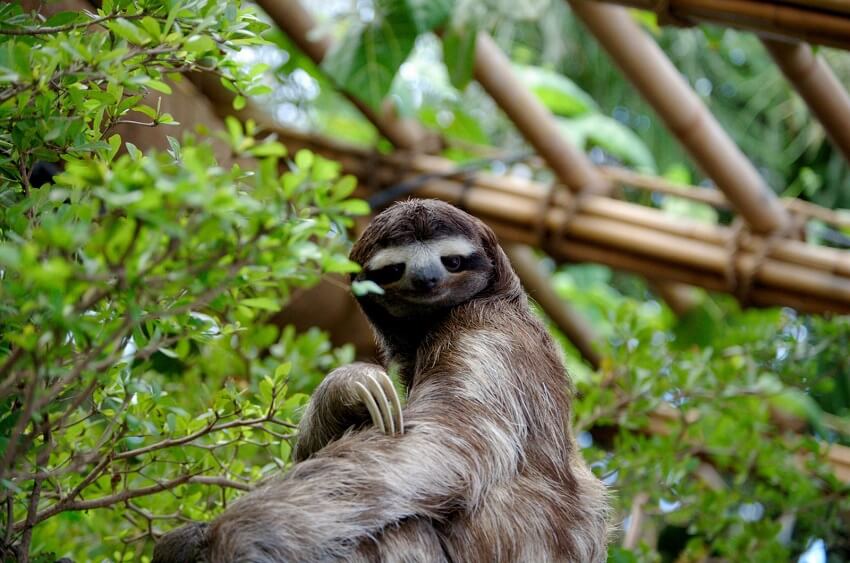
1.4. The Laziest Animal on the Planet
A sloth’s toes are naturally curved to hang from trees, and they don’t need to hold on to anything. They just hook their claws over a branch. Sloths have three extra vertebrae in their necks and specially adapted internal organs, which allow them to sleep while hanging upside down with their heads resting on their chests for long periods. They are the ultimate nappers, sleeping more than 20 hours a day. While monkeys occasionally groom each other, sloths do not.
They don’t even care that algae grows all over their fur. When they give birth, their young just lie and sleep on the mother’s belly, and they even eat and go to the bathroom right there. When the forests are flooded, they can also swim to find another branch, but this is very rare.
However, the typical image of a sloth as a lazy animal that sleeps all day may not be entirely accurate. Instead of sleeping more than 16 hours a day, as observed in captive conditions, sloths in the wild sleep for less than 10 hours a day. Sloths sleep only 9.6 hours a day. While they are still slow-moving, their sleep patterns are not completely abnormal. Captive animals often sleep more because all their needs are met.
1.5. Sloth Body Characteristics
Sloths live in the tropical rainforests of Central and South America. Their long, shaggy arms make them look like monkeys at first glance. They are about 0.6 to 0.8 meters (2 to 2.6 feet) in length and weigh between 3.6 to 7.7 kg (8 to 17 lbs), depending on the species.
Sloths can distinguish colors but have very poor eyesight and hearing. Therefore, they must find food using their sense of touch and smell. This species also has a very low metabolic rate (less than half that of other mammals). Sloths are thermic animals, which means their body temperature can change depending on the environment, usually from 25° to 35°C (77° to 95°F), but it can also drop to 20°C (68°F).
Sloths are divided into two main species: one with two claws on their front feet and one with three. They have very similar appearances with a round head, sleepy eyes, tiny ears, and a plump tail. The two-toed sloth is larger in size. This species spends most of its time hanging upside down from tree branches. The three-toed sloth, on the other hand, prefers to sit upright on branches. The facial coloring of the three-toed sloth makes it look like it’s always smiling. They also have two extra neck vertebrae, which allows them to turn their heads up to 270 degrees.
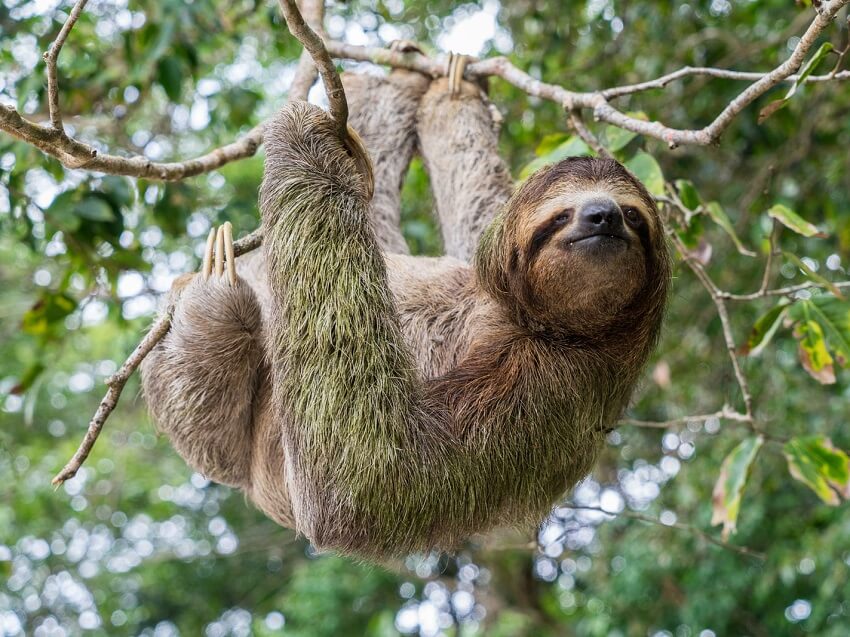
1.6. Sloth Behavior
Some scientists believe that a sloth’s slow nature helps it go unnoticed by predators like hawks and big cats. In addition to providing nutrients for their fur, the algae that grows on their bodies also acts as an excellent camouflage “coat” in the dense green canopy.
Sloths rarely move. About once a week, they descend to the ground and clean themselves by slowly using their claws to pull dirt out of their fur. If they are caught by a predator, they quickly transform from a slow-moving creature into a true “professional fighter.” They will bite and use their claws to strike their opponent repeatedly, then let out a loud scream.
Sloths use their long arms to paddle through water, cross rivers, and swim between islands. They can also lower their metabolism and slow their heart rate to one-third of normal to dive underwater for up to 40 minutes.
1.7. Reproductive Habits
The two-toed sloth gives birth to only one offspring per litter. For the first six months, the baby has three toes; it isn’t until 12 months that it develops two toes. Female sloths typically give birth to one offspring each year, but sometimes, due to their slow-moving nature, they may not find a mate even after more than a year has passed.
There are no significant physical differences between male and female sloths, so many zoos have mistaken their sexes when trying to breed them. The average lifespan of a two-toed sloth in the wild is 20 years, and it can live up to 30 years in captivity.
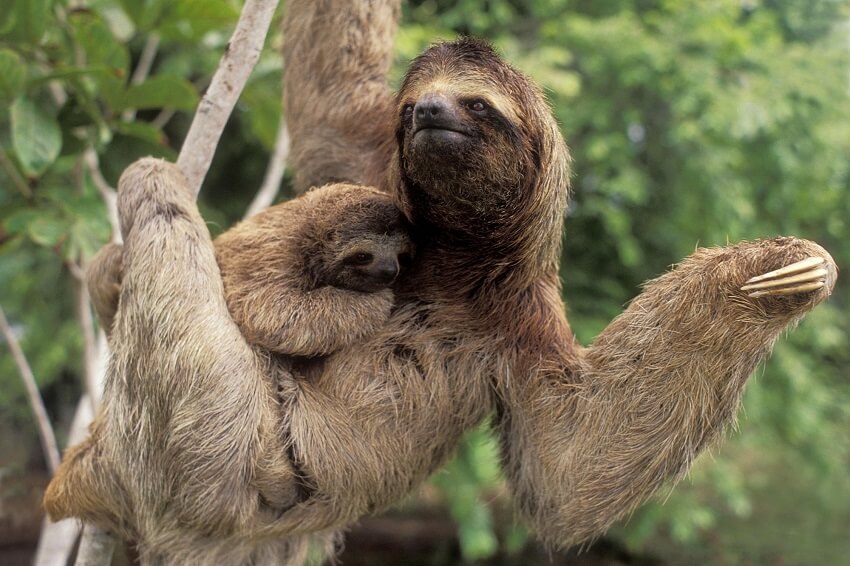
1.8. The Sloth’s Diet
The sloth’s diet is not very nutritionally diverse. Coupled with its slow movement and minimal foraging, it needs a large, multi-chambered stomach to hold a lot of food. A sloth can take up to a month to digest a single meal, and it needs a low-activity lifestyle to keep its energy metabolism as low as possible. This often causes the sloth’s body temperature to drop very low. When its body temperature gets too low, the gut bacteria stop working, which means that even if the sloth has eaten enough for a whole month, it can still die of starvation because the food in its digestive tract is not being digested.
Sloths spend most of their lives eating, sleeping, and resting in the tropical forest canopy. Most herbivores supplement their diet with more energy-rich foods like fruits and nuts, but sloths, especially the three-toed variety, rely almost entirely on tree leaves. They have developed a sophisticated strategy to cope with this limited diet. First, they try to absorb the maximum amount of energy from their food. Sloths have a multi-chambered stomach that takes up to a third of their body; they can take 5 to 7 days, or even several weeks, to digest a meal.
1.9. The Sloth’s Clever Symbiotic Strategy
Because they lack self-defense abilities and speed, sloths choose to use camouflage to avoid predators. They host an entire ecosystem in their fur, including symbiotic algae, numerous microorganisms, parasitic arthropods, and a species of moth. Moths live on the sloth’s body, and their presence, combined with the color of the algae, can fool other predators into thinking the sloth is just a part of a tree trunk. The fact that they are mostly motionless or move very slowly further enhances this camouflage.
The problem is that when the moths lay their eggs, they need a warm, secluded place with plenty of nutrients to feed the larvae. There is no more convenient place than the sloth’s own feces. This creates a two-for-one situation. When the moths mature from the feces and fly back onto the sloth, they carry nutrients from the sloth’s waste to feed the community of microorganisms and algae living on its body. That’s why sloths are so meticulous about their bathroom habits.
1.10. Threats Facing Sloths
While not all sloth species are endangered, some of the six species are threatened by habitat loss. Deforestation in the tropical rainforests of South and Central America poses a danger to the trees that sloths rely on for food and shelter. Through a program called ARPA for Life, the WWF has helped the Brazilian government create a $215 million fund to ensure that 150 million acres of the Brazilian Amazon are properly managed.
Sloths spend most of their time in the tree canopy, descending only once a week to relieve themselves. Trees provide natural protection from predators like jaguars and eagles; it is safer for sloths to be motionless and camouflaged on the ground. However, they will risk descending on rare occasions to find more food or a mate.
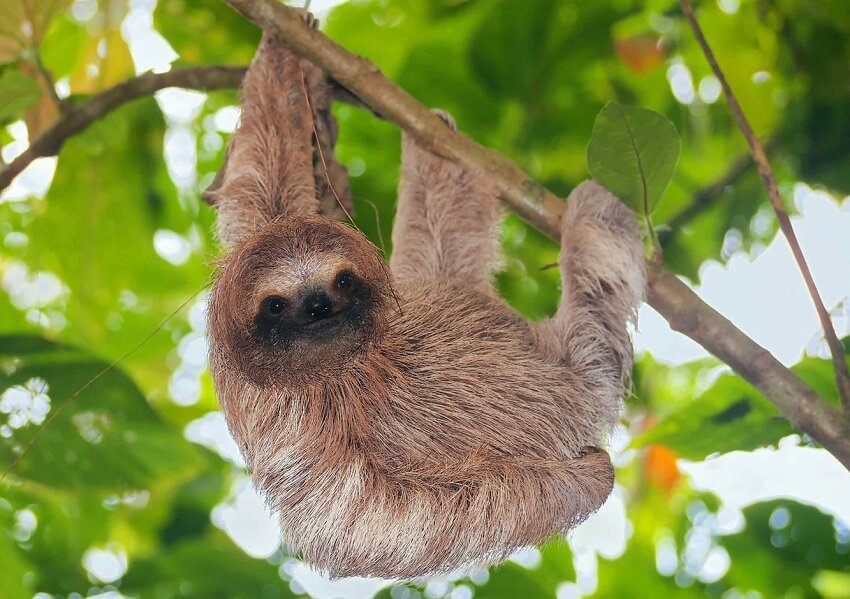
2. FAQs
1. How fast can a sloth move?
When climbing, a sloth’s speed is about 4 meters (13 ft) per minute, and when it feels threatened, it can increase its speed to 4.5 meters (15 ft) per minute. On the ground, their speed is even slower, at only about 3 meters (10 ft) per minute.
2. How long do sloths sleep each day, and do they really sleep for 20 hours as people often think?
In captivity, sloths can sleep more than 20 hours a day. However, in the wild, they usually sleep less only about 9.6 hours a day because they have to forage for food and avoid predators.
3. What physical characteristics allow sloths to live a slow but safe life?
Sloths have curved claws to hook onto tree branches, three extra neck vertebrae that allow them to turn their heads up to 270 degrees, a body temperature that fluctuates with the environment, and a very low metabolic rate—all of which help them conserve energy.
4. How do sloths eat and digest food?
Their diet consists mainly of leaves, which are low in energy. It takes days to weeks to fully digest a single meal due to their slow digestive system. Their multi chambered stomach helps them hold a lot of food, but if their body temperature drops too low, their gut microbes stop working, which means the undigested food can pose a risk to them.
5. Do sloths have any special survival tactics against predators?
Yes. Sloths live quietly and move slowly, and they have a layer of algae growing on their fur for camouflage. The symbiotic ecosystem on their fur (algae, microorganisms, moths, etc.) helps them blend in with the forest environment, making them difficult for predators to spot.
3. Conclusion
The sloth is living proof that being slow doesn’t mean being weak. Thanks to their special biological features, their slow sleep and movement, and their excellent camouflage tactics, they have survived for millions of years in a challenging natural environment. We hope these Interesting Facts About Sloths not only enrich your knowledge but also help you appreciate the gentle and unique beauty of these seemingly “lazy” but incredibly sophisticated creatures.



